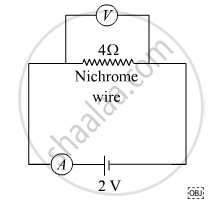Advertisements
Advertisements
प्रश्न
A V-I graph for a nichrome wire is given below. What do you infer from this graph? Draw a labelled circuit diagram to obtain such a graph.

उत्तर

The graph between V & I is a straight line.
So we can conclude that Current flowing through the wire is directly proportional to the potential difference V across it.
The resistance of the wire can be calculated as
`"R" = "v"/1 = 0.4/0.1 = 4Ω`
We can also conclude that nichrome wire has a constant value of the resistance as 4 Ω4 Ω.
nichrome wire follows ohm's law thus it behaves as an ohmic conductor.
The circuit diagram corresponding to the above graph is as shown below.

APPEARS IN
संबंधित प्रश्न
State two causes of energy loss in a transformer.
You have three resistors of values 2Ω, 3Ω and 5Ω. How will you join them so that the total resistance is more than 7Ω?
1) Draw a diagram for the arrangement
2) Calculate the equivalent resistance.
What is a voltmeter?
Ohm's law state a relation between potential difference and ___________.
State the S.I. unit of electric potential.
Water in the waterfall flows from a higher level to the lower level because of ____________.
Define the following:
Potential difference
How will you conclude that the same potential difference (voltage) exists across three resistors connected in a parallel arrangement to a battery?
Find out the following in the electric circuit given in Figure
- Effective resistance of two 8 Ω resistors in the combination
- Current flowing through 4 Ω resistor
- Potential difference across 4 Ω resistance
- Power dissipated in 4 Ω resistor
- Difference in ammeter readings, if any.

What is the measure of the work done on the unit positive charge to bring it to that point against all electrical forces?
